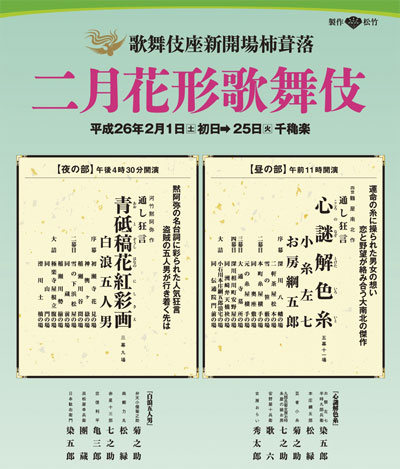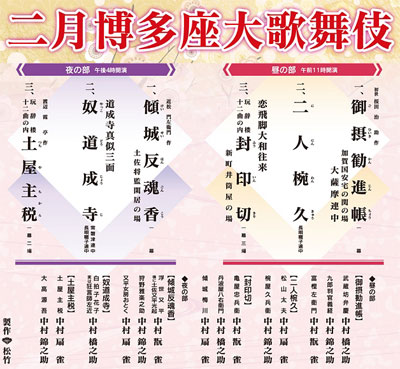| Comments |
11th month celebrating the opening of the new Kabukiza within a 1-year long cycle of kokera otoshi programs.
Kokoro no Nazo Toketa Iroito: this is a play written by Tsuruya Nanboku IV in 1810.
Yamazumi Goheita (Onoe Matsuya), an evil retainer of Lord Akagi (Nakamura Kash˘) loves the geisha Koito (Onoe Kikunosuke).
He needs money to ransom her, so he steals the certificate of the heirloom of his lord, pawns it and receives
200 ry˘ gold coins. Ishizuka Yasobŕ (Matsumoto Kingo),
another retainer of Lord Akagi, is in charge of preserving the certificate and is blamed for losing it.
Another retainer of Lord Akagi, Honj˘ Tsunagor˘ (Onoe Sh˘roku) offers to be masterless and search for the certificate
as he feels indebted to Ishizuka Yasobŕ. Koito falls in love with a fireman Sashichi (Ichikawa Somegor˘), Yasobŕ's son.
They encounter Tsunagor˘ and promise to help him search for the certificate. Koito's brother Hantoki Kurobŕ (Ichikawa Somegor˘)
encounters a girl entertainer on a snowy road who would go from door to door performing auspicious songs and
dances at New Years. He kills her as she has money not knowing she is his daughter. Sagobŕ (Kataoka Matsunosuke),
the head clerk of a thread shop, is a villain who helps Goheita. He tries to marry Ofusa (Nakamura Shichinosuke),
the daughter of the thread shop owner, and make the shop of his own. Ofusa is in love with Tsunagor˘.
The shop keeper decides to adopt Kambaraya Sagor˘ (Nakamura Matsue) as husband for Ofusa. Sagobŕ plans to poison her,
then counteract the poison and make her of his own. Ofusa is regarded as dead after drinking poisoned
sake and buried with 100 ryo gold coins betrothal money. Hearing of this,
Tsunagor˘ breaks the grave open to obtain the money to get the certificate,
when Ofusa revives and asks him to elope with her, to which he consents. Koito utters spiteful words toward
Sachichi and pretends to have come to love Goheita in order to get information on whereabouts of the certificate.
Sashichi gets angry, lies in ambush and kills her not knowing her true intention.
From a message left behind by her, it turns out that Kurobŕ is her brother.
Ofusa's sister Otoki (Nakamura Shichinosuke) fell in love with Juemon, a young vassal of Lord Akagi, as she served Lady Akagi.
She eloped with him. She married Juemon who changed his name to Kurobŕ and they have done one evil deed
after another. They pull a badger game against Tsunagor˘. It turns out that Tsunagor˘ was once Otoki's fiance
and is now Ofusa's love and that Kurobŕ killed his own dahghter Okimi whom he had abandoned.
They regret having done evil deeds and decide to mend their ways. They feel relieved to know that Tsunagor˘
will be able to get the certificate. At the moment Sagobŕ abducts Ofusa.
Aoto Z˘shi Hana no Nishikie:
(A Brocade Print of the Age of Magistrate Aoto)
Written by Kawatake Mokuami in 1862, this play focuses on the thief Benten Koz˘ and was
inspired by a woodblock print of a sexy young man with tattoos covering his body with a
woman's hairstyle and kimono. Benten Koz˘ is a swindler and thief who makes use of his beauty,
both as a handsome young man and disguised as a beautiful woman. The sections about Benten Koz˘
are played frequently, but this marks a rare full-length performance that shows the stories of
all five thieves in the gang who are tied together by bonds of fate and obligation.
In the opening at a magnificent temple surrounded by cherry blossoms, Benten Koz˘
poses as a samurai youth and seduces a princess setting off events that will eventually destroy
Benten and all around him. A beautiful young woman comes to a clothing store with her servant,
but is discovered shoplifting and beaten. When she proves that she was not stealing,
her servant demands compensation. However, a samurai who happens to be in the store reveals
that the young woman is actually a man, and he proudly announces his name as Benten, the thief.
The servant is his fellow gang member Nang˘ Rikimaru and the samurai is actually
the head of the gang Nippon Daemon. However, they learn that the man they have defrauded
is actually Benten Koz˘ĺs father and the five thieves realize they cannot escape and
decide to wear magnificent matching kimonos as they meet their fate.
The act ends with a kind of spectacle showing the five members of the gang in their finest
kimonos under the cherry blossoms in full bloom. In elaborate speeches, they each
announce their name in the poetic diction for which the playwright Mokuami is famous.
Finally Benten Koz˘ fights off his pursuers in a spectacular fight on the roof of a temple.
Starring Onoe Kikunosuke as Benten Koz˘, Ichikawa Somegor˘ as Nippon Daemon, Onoe Sh˘roku as Nang˘ Rikimaru,
Nakamura Shichinosuke as Akaboshi Jűzabur˘ and Band˘ Kamesabur˘ as Tadanobu Rihei.
Also featuring Nakamura Baishi and Ichikawa Danz˘ as Princess Senju and Hamamatsuya K˘bŕ.
Source: Earphone Guide website
|



